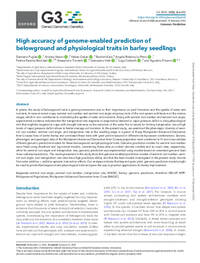High accuracy of genome-enabled prediction of belowground and physiological traits in barley seedlings

Authors:
In plants, the study of belowground traits is gaining momentum due to their importance on yield formation and the uptake of water and nutrients. In several cereal crops, seminal root number and seminal root angle are proxy traits of the root system architecture at the mature stages, which in turn contributes to modulating the uptake of water and nutrients. Along with seminal root number and seminal root angle, experimental evidence indicates that the transpiration rate response to evaporative demand or vapor pressure deficit is a key physiological trait that might be targeted to cope with drought tolerance as the reduction of the water flux to leaves for limiting transpiration rate at high levels of vapor pressure deficit allows to better manage soil moisture. In the present study, we examined the phenotypic diversity of seminal root number, seminal root angle, and transpiration rate at the seedling stage in a panel of 8-way Multiparent Advanced Generation Inter-Crosses lines of winter barley and correlated these traits with grain yield measured in different site-by-season combinations. Second, phenotypic and genotypic data of the Multiparent Advanced Generation Inter-Crosses population were combined to fit and cross-validate different genomic prediction models for these belowground and physiological traits. Genomic prediction models for seminal root number were fitted using threshold and log-normal models, considering these data as ordinal discrete variable and as count data, respectively, while for seminal root angle and transpiration rate, genomic prediction was implemented using models based on extended genomic best linear unbiased predictors. The results presented in this study show that genome-enabled prediction models of seminal root number, seminal root angle, and transpiration rate data have high predictive ability and that the best models investigated in the present study include first-order additive × additive epistatic interaction effects. Our analyses indicate that beyond grain yield, genomic prediction models might be used to predict belowground and physiological traits and pave the way to practical applications for barley improvement.
